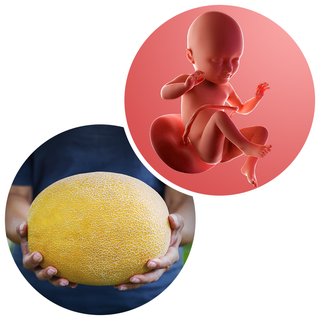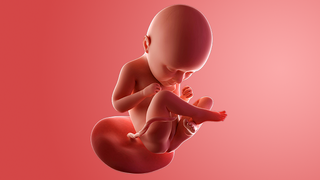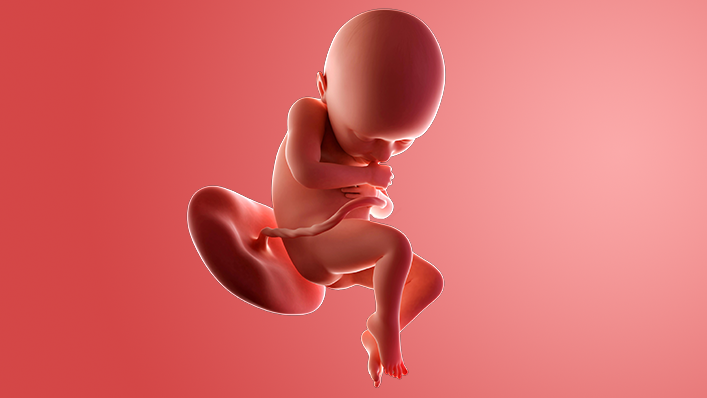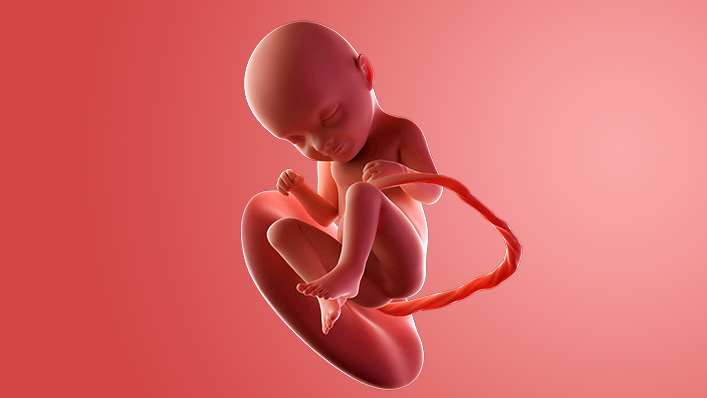What's happening in my body?
Perhaps it feels as though some of your pregnancy symptoms have vanished. This can happen when your baby moves head down into the pelvis, in a staged process called "engagement".
This drop down is called "lightening". It frees up space in your abdomen, and gives your lungs a bit of a break, so if you've been feeling breathless, that should ease up.
It also reduces the pressure on your stomach, so symptoms such as heartburn could disappear as well.
This shift may feel like a relief, but it does not mean you're about to give birth, as you'll probably have to wait several more weeks for that to happen.
You may also find that you now need to pee more and walking could be more of a struggle.
When to take maternity leave
You could be finding work difficult right now, especially if you travel on public transport or have a job that involves standing up.
You have probably already chosen a date for your maternity leave to start. The earliest that you can usually start your leave is 11 weeks before the expected week of the birth.
However, if your baby comes early, then your leave will start the day after the birth. If you are off work with a pregnancy-related illness in the 4 weeks before your due date, it will start from then.
Some people find it suits them to keep working right up until the birth. If you think that suits you too, then do what feels right for you.
Speak to your midwife or doctor if you'd like advice about when to stop working.
If you want to change the date when you start your leave, then you will need to give your employer at least 28 days' notice, or let them know why this is not possible.
You have probably already chosen a date for your maternity leave to start. The earliest that you can usually start your leave is 11 weeks before the expected week of the birth.
Baby sling safety
Many parents use a sling or baby carrier instead of a pram to keep their baby close to them.
If you decide to use a sling, make sure you know how to use it safely, as a small number of deaths from suffocation have been linked to slings.
The Royal Society for the Prevention of Accidents (RoSPA) advises the safest slings are the ones that hold your baby solidly against your body, in an upright position.
Make sure you can see your baby, that their face is not restricted, and their airways are always clear.
The "Ticks" rule to keep your baby safe when wearing a sling or carrier is:
- T – tight
- I – in view at all times
- C – close enough to kiss
- K – keep chin off the chest
- S – supported back
Read more about sling safety and the "Ticks" rule on the RoSPA website.
3rd trimester pregnancy symptoms (at 34 weeks)
Your breasts could feel huge and may be leaking small amounts of yellowish colostrum. This is early milk that's rich in antibodies and will help to protect your baby from diseases if you choose to breastfeed.
If your breasts are sore, then it may help to wear a light bra at night and a more supportive bra during the day.
You should sleep on your side. Evidence shows that it's best for the baby, as it helps the blood flow to the placenta. You're also less likely to get backache.
Your signs of pregnancy could also include:
- painless contractions around your bump, known as Braxton Hicks contractions
- sleeping problems (week 19 has information on feeling tired)
- stretch marks (week 17 has information on stretch marks)
- swollen and bleeding gums (week 13 has information on gum health during pregnancy)
- pains on the side of your baby bump, caused by your expanding womb ("round ligament pains")
- piles (week 22 has information on piles)
- headaches
- backache
- indigestion and heartburn (week 25 has information on digestive problems)
- bloating and constipation (week 10 has information on bloating)
- leg cramps (week 20 has information on how to deal with cramp)
- feeling hot
- dizziness
- swollen hands and feet
- urine infections
- vaginal infections (week 15 has information on vaginal health)
- darkened skin on your face or brown patches – this is known as chloasma or the "mask of pregnancy"
- greasier, spotty skin
- thicker and shinier hair
You may also experience symptoms from earlier weeks, such as:
- mood swings (week 8 has information on mood swings)
- morning sickness (week 6 has information on dealing with morning sickness)
- weird pregnancy cravings ( week 5 has information on pregnancy cravings)
- a heightened sense of smell
- sore or leaky breasts (week 14 has information on breast pain) – a white milky pregnancy discharge from your vagina and light spotting (seek medical advice for any bleeding)
What does my baby look like?
Your baby, or foetus, is around 45cm long from head to heel. That's approximately the size of a cantaloupe melon.
Your baby is curled up inside your uterus (womb), with their little legs bent up towards the chest.
There's not a lot of space in there, but you should still feel your baby shifting around and see your bump change shape too.
If you've got a little boy in there, then his testicles will be descending from his abdomen into his scrotum.
When he's born, his genitals may look quite enlarged. This is swelling caused by extra fluid or a late rush of hormones – it goes down after a few days.

Action stations
Read the National Institute for Health and Care Excellence (NICE) guidelines to antenatal care. If you’re not happy with any aspect of your care, then speak up, and tell your midwife or doctor.
This week you could also...
More in week-by-week

Week 35
Many choose to begin their maternity leave around now, and then use the next few weeks to prepare for the baby's arrival. Others prefer to work until the birth.
Do what feels right for you.
More in week-by-week guide to pregnancy


